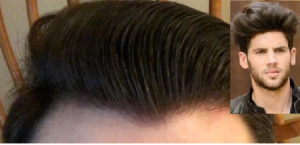I have heard this from many patients
You need to get good baselines, like a HAIRCHECK test (https://baldingblog.com/haircheck-test-how-it-is-done-video/) and once it is confirmed then taking finasteride is a good idea because this medication can reverse the balding process in someone of your age. Get a good doctor who can give you a Personalized Master Plan for now and the future
The younger you are, the better the finasteride works. This applies in most men; however, there are a few men who are going to develop advanced balding patterns by their mid-20s or earlier and the effects of finasteride on them is much less valuable. Look to your father or grandfathers patterns of balding to see if you may fall into this category.
The only way a hair transplant is normal looking after it is performed, is to transplant the natural growing groups that hair normally grows in, in their anatomical groups, i.e. the follicular Unit. The average Caucasian averages about 2.2 hairs per follicular unit and the typical human has approximately 50,000 of these follicular units on their entire scalp. So if the average hair count per follicular unit is 2.2 hairs/follicular unit, then the typical Caucasian man has approximately 110,000 hairs on their scalp. For the typical Asian, the follicular count remains at ~50,000 but the average hair count per follicular unit drops to 1.9 hairs/follicular unit for a total hair count of ~95,000 hairs. This is an average, but the range could be wide ranging from 75,000 hairs – 120,000 in any given population.
This is a picture of a 6 hair follicular unit (rare in most people) but worth showing because it shows new hairs in their growth phase. Notice that two of the hairs are shorter than the other four (marked with arrows). These are new anagen hairs growing into this follicular unit increasing the visual hair count by 1/3rd from 4 to 6 hairs. That means that possibly a few months before this follicular unit was excised, it probably had only 4 hairs that were visible. The two new anagen hairs arose from stem cells within the follicular unit. It is likely, that if we allowed this to grow (and were able to follow the hair count in this follicular unit over a year or so), the hair count may actually drop as some of these longer hairs (terminal hairs) may actually turn into their sleep phase (telogen).
Telogen Effluvium is a short term process often related to stress and more common in women usually reversing within a year or less, while diffuse thinning from genetic causes last, are often slowly progressive and generally can get worse over time until your inherited balding pattern is achieved (often before the age of 40, but not always).
I rarely see a juvenile hairline in evolution as I did today. This 25 year old man saw a dermatologist last year for this problem and as the dermatologist didn’t understand what he was seeing, he put the man on finasteride to stop that is unstoppable, the evolution of a mature hairline. Unfortunately, this man developed sexual side effects, weight gain, more stress, a dropping testosterone and he didn’t feel good. That is bad medicine as far as I am concerned. Finasteride should never be prescribed for a maturing hairline.
The photos that he allowed me to used today have been labeled as follows: (1) shows where the rounded juvenile hairline still persists but it is clearly weak and disappearing, (2) shows where the juvenile hairline appeared on the left side, (3) shows the right side which is more advanced and the mature hairline is starting to appear, and (4) shows the patient with his eyebrows lifted high and his forehead wrinkles showing where the hairline originally was, slightly below the widow’s peak that he still has. Many of the Reddit readers have experienced this, so seeing it in such a dramatic presentation will help all of you understand what you are experiencing when your hairline matures. This is not BALDING and finasteride will have no impact on this process!
For the post-op users that did the fue transplant and were prescribed finasteride, is the prescription supposed to be taken forever or just for a few month? I am 90% on board and about to book but I’m hesitant bc I don’t want to take a pill forever and I was reading about the side effects and I that pushes me away from it. I know the answer is probably on here but I want to hear from actual, firsthand users.
Thanks for your replies in advance.
If you don’t get sexual or other side effects, then since genetic hair loss is progressive, I generally advise patients to stay on it for life. It has the advantage when you are older, of reducing the risk of prostate cancer by 25% in addition to slowing down the hair loss that is almost always progressive.
You have moved from a juvenile hairline to a Mature hairline. Do you really want to transplant that now? Think twice. Hair transplant surgeons rarely restore the juvenile hairline; however, I did it once, on a ‘Soap Opera Day-time Star’ who had to have his juvenile hairline back to keep his job which earned him over $1 million/year. I don’t think that you will find a doctor willing to bring back that hairline you had shown in the right upper hand corner of the photos.
Hey I’m 19 and In thinning around the hairline I’m now on 0.5g finasteride since 2 weeks and me question is will finasteride thicken these fine hairs on the hairline or do I need to Derma roll?
Provided you are not talking about the loss of your juvenile hairline in developing a maturing hairline, a 19 year old with early genetic Class 3 type hair loss may reverse the process on finasteride. Finasteride will not help you hold on to a juvenile hairline or bring it back.
What would you say is the most effective growth agonist? I’ve heard people say oral minoxidil, but is topical estrogen also capable of reviving follicles after they’ve dormant for a few years?
Reviving dormant follicles is not something that may always happen. The places were we see revival is usually when the loss is less than a year, two at most. Those who have had long term balding may not be able to revive those hairs. The traditional approaches all have value including Microneedling, minoxidil (oral or topical) and finasteride. Estrogens in the face of high testosterone may have more limited value.
What I’ve noticed: those miniaturized hairs (1) are terminal hairs but barely grow longer than 1 inch; (2) can be easily pulled out from roots by hand and will take even longer time to grow back; (3) the hair pulled out with roots mostly missed the white gooey stuff presented in healthy hairs.
Miniaturized hairs can easily be pulled out but be careful as they may not come back. They often do not grow in advanced stages of miniaturization
I’ve been on minoxidil for about 7 months now and it doesn’t seem to be helping. Is retrograde alopecia not androgenic? I always just thought it was a weird pattern of genetic hair loss but some people on this thread are saying there can be causes… is that true? What kind of causes?
I think that this may be some ill defined inherited issue where particular hairs undergo Apoptosis based upon programmed death. This also happens in genetic male patterned balding but that was defined for a huge population. I haven’t seen anyone who has ever done a study of retrograde alopecia with with inheritance as a focus.
Page 179 of 1247







